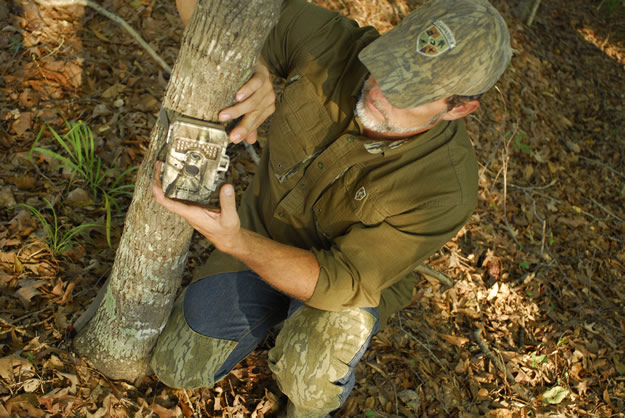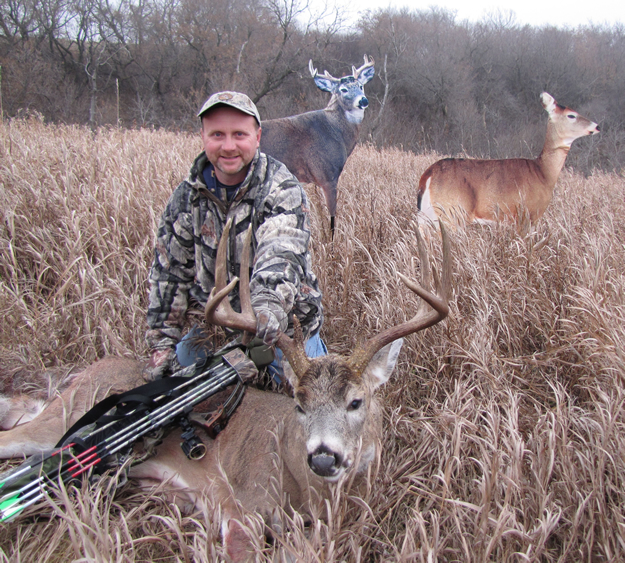
Editor’s Note: D.J. Randolph of Velva, North Dakota, is the Mossy Oak regional manager for North Dakota, South Dakota, Montana, Wyoming, Nebraska and Alaska. A Mossy Oak Pro Staff hunter since 2008 and a Pro Staff Manager for the last 3 years, he’ll begin to hunt antelope on Labor Day weekend.
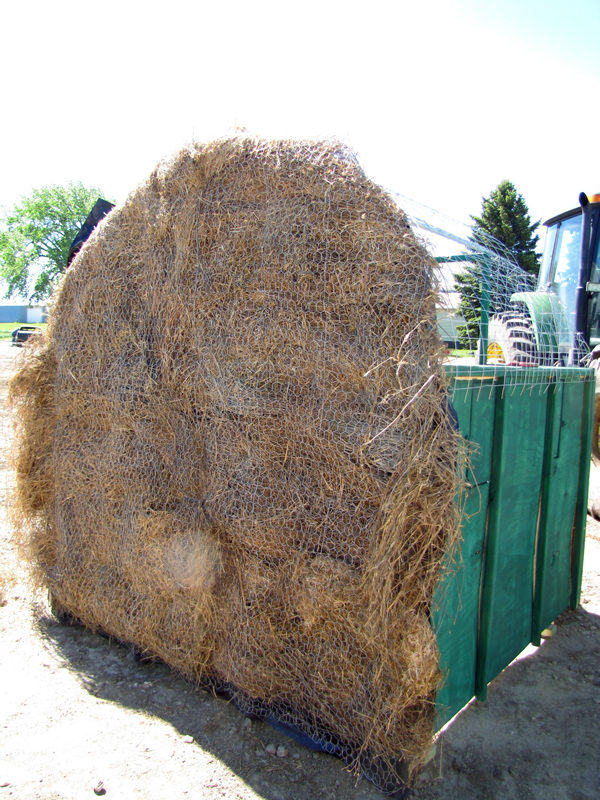 North Dakota’s whitetail season begins on Labor Day weekend, and I like to hunt open prairie croplands. North Dakota’s not exactly famous for having large trees. So, I build some portable ground blinds and permanent ground blinds where I can hide to hunt. My favorite way to hunt is to hunt from hay bale blinds that I build, because the hay bale blinds are much more forgiving than commercially-built blinds. We build a rigid frame, wrap chicken wire around the frame, put straw over the chicken wire and then place another layer of chicken wire over the straw to hold it in place. After we set the blind up, we put another layer of straw over the top layer of chicken wire. Then the blind looks exactly like a hay bale. If you set that blind between two bales of hay, you won’t be able to pick out the blind from the hay bales. Once we get the blind built, we take a pair of wire snips and cut out our shooting ports. Then, we can bend the wire back to open and close the shooting ports. We set these ground blinds up on the edges of crop fields, or where two crop fields come together.
North Dakota’s whitetail season begins on Labor Day weekend, and I like to hunt open prairie croplands. North Dakota’s not exactly famous for having large trees. So, I build some portable ground blinds and permanent ground blinds where I can hide to hunt. My favorite way to hunt is to hunt from hay bale blinds that I build, because the hay bale blinds are much more forgiving than commercially-built blinds. We build a rigid frame, wrap chicken wire around the frame, put straw over the chicken wire and then place another layer of chicken wire over the straw to hold it in place. After we set the blind up, we put another layer of straw over the top layer of chicken wire. Then the blind looks exactly like a hay bale. If you set that blind between two bales of hay, you won’t be able to pick out the blind from the hay bales. Once we get the blind built, we take a pair of wire snips and cut out our shooting ports. Then, we can bend the wire back to open and close the shooting ports. We set these ground blinds up on the edges of crop fields, or where two crop fields come together.
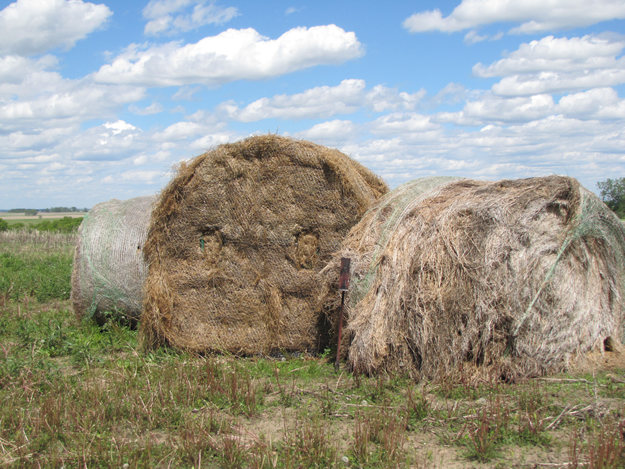 One of our big challenges is that crops are rotated in North Dakota from year-to-year. So, if there’s a field that has soybeans and sunflowers planted next to each other, that’s a great place to set-up your blind and hunt in the corner of the field. But the next year the farmer may plant wheat and barley in those two fields. Since deer aren’t interested in either of those crops, we have to move our blinds around quite a bit from year-to-year. We have to glass a lot from long distances and run numbers of trail cameras to find the bucks and where they're feeding. In the spring, we’ll be able to determine what crops are being planted in which field. Once we know that information, we move our ground blinds to the agricultural fields we feel the deer will feed in most often. Before we set-up our ground blinds, we make sure we talk to the farmer. We tell him where and how we want to set-up our blinds, and we assure him we won’t damage any of his crops.
One of our big challenges is that crops are rotated in North Dakota from year-to-year. So, if there’s a field that has soybeans and sunflowers planted next to each other, that’s a great place to set-up your blind and hunt in the corner of the field. But the next year the farmer may plant wheat and barley in those two fields. Since deer aren’t interested in either of those crops, we have to move our blinds around quite a bit from year-to-year. We have to glass a lot from long distances and run numbers of trail cameras to find the bucks and where they're feeding. In the spring, we’ll be able to determine what crops are being planted in which field. Once we know that information, we move our ground blinds to the agricultural fields we feel the deer will feed in most often. Before we set-up our ground blinds, we make sure we talk to the farmer. We tell him where and how we want to set-up our blinds, and we assure him we won’t damage any of his crops.
My best buck I ever took in North Dakota scored 150 Pope & Young points typical. I found this buck in one of my favorite hunting spots where a deep ravine came up and out into a crop field, about a mile from the road. We could watch that site from the road. When I first started hunting in North Dakota, I had a hard time trying to determine how to most effectively hunt whitetails out here. Finally, I learned that when I could find a bedding area that came up and cornered into a crop field, we’d always see nice bucks. But I never could figure out how to hunt those places. We consistently saw nice bucks in this one place. The year before I hunted this site, the farmer had baled-up and left flax straw near that corner of the field. Flax straw lasts forever - well almost forever - and has very little commercial value. So, I asked the farmer if I could buy two bales of that flax straw. He said, “No, but I’ll give you those two bales.” So, I maneuvered those two bales of flax straw into the corner of the field where we had been seeing the bucks come out and built a bale blind between those bales of flax straw. If you looked out across the field, three bales of flax straw appeared to be sitting in the corner of the field. I knew a lot of good whitetail bucks were in that area, because I had put out numbers of trail cameras.
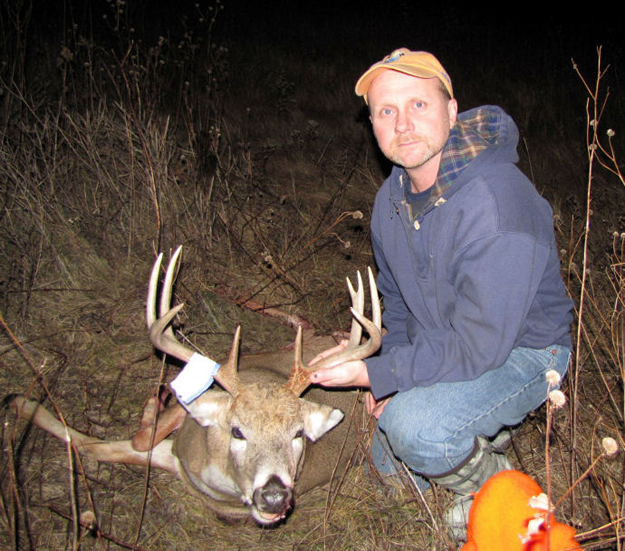 In the fall of the year, I started hunting there and let a number of good-sized bucks walk by my blind that I didn’t shoot. I knew bigger bucks were there. On a fairly cold day, I had a nice 4x4 buck (an 8 pointer by eastern count) standing in front of my blind, and a doe walked up and joined him. We often hunt with decoys out here, because from a distance, a buck can see those decoys and may come to them. I've learned that when you set-up a stand and put-out decoys close to a bedding area where a buck can see them, the buck either will come because he's curious to see who these two new deer are, or he’ll come in stiff-legged and bristled-up, if he's a big buck, to try to run off the buck and the doe decoy.
In the fall of the year, I started hunting there and let a number of good-sized bucks walk by my blind that I didn’t shoot. I knew bigger bucks were there. On a fairly cold day, I had a nice 4x4 buck (an 8 pointer by eastern count) standing in front of my blind, and a doe walked up and joined him. We often hunt with decoys out here, because from a distance, a buck can see those decoys and may come to them. I've learned that when you set-up a stand and put-out decoys close to a bedding area where a buck can see them, the buck either will come because he's curious to see who these two new deer are, or he’ll come in stiff-legged and bristled-up, if he's a big buck, to try to run off the buck and the doe decoy.
On this day, I had a buck and a doe decoy set-up, and I had a live buck and doe out in front of my blind. I believe the decoys brought the small buck and doe in close to my blind to feed. Way off in the distance, I spotted a big buck come out of the trees into the field, and I knew this was the buck I wanted to take. My decoys and my two live deer worked exactly like they should have. Once the big buck spotted my two decoys and the two live deer, immediately, he changed his posture. I could see him bristle-up and could tell he was the dominant buck in the area. He didn’t like having that live buck and doe or the decoys near the bedding area. The big whitetail started coming toward the blind slowly and stiff-legged with his head down. Occasionally, he grunted as he approached. When he reached 30 yards, he presented a broadside shot. I drew my bow and released the arrow.
Yesterday: September Wyoming Antelope - How to Find and Take Them
Tomorrow: Bowhunting North Dakota’s Moose – Difficult to Get This Once in a Lifetime Tag














